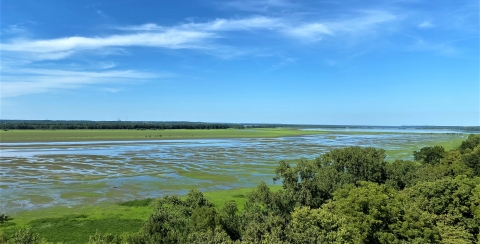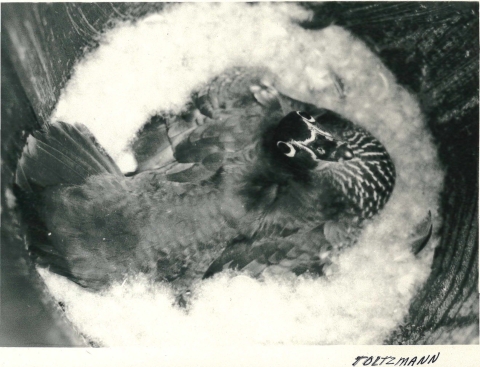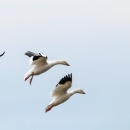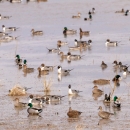About Us
Chautauqua National Wildlife Refuge was established in 1936 for the main purpose of providing sanctuary for the millions of birds that migrate along the Illinois River. Today, the refuge provides sanctuary and breeding ground for migratory birds, fish and other wildlife. The refuge has been designated as an Important Bird Area, accepted into the Western Hemisphere Shorebird Reserve Network and designated as a Ramsar Wetland of International Importance. The refuge is part of the traditional homeland of the Illinois people, past and present. Today, the Illinois people are recognized as the Peoria Tribe of Indians of Oklahoma, a confederation of Kaskaskia, Peoria, Piankeshaw and Wea tribes of Illinois and Indiana. They are descendants of those who created the great mound civilizations in the central Unites States. Subsequent tribes that also lived here were the Kickapoo and Potawatomi. We honor with gratitude their past and present as we continue stewardship of these lands, waters, fish and wildlife.
The refuge is managed as part of the Illinois River National Wildlife and Fish Refuges Complex, which stretches along 124 miles of the Illinois River in west central Illinois, and consists of three refuges: Emiquon, Chautauqua and Meredosia. This complex totals 13,000 acres of backwater lakes, bottomland forests, floodplain wetlands and upland habitats and provides habitat for 60% to 70% of the waterfowl that migrate along the Illinois River.
Chautauqua National Wildlife Refuge is located along the Illinois River in Mason County, just eight miles north of Havana, Illinois. The 4,793-acre refuge serves as the headquarters for the complex and manages the Cameron-Billsbach Division, which is in Marshall County, between Sparland and Henry, Illinois. The refuge includes roughly 3,500 acres of moist soil, 760 acres of bottomland forest, 140 acres of open water and 120 acres of upland woods. The refuge is also home to a rare, 100-foot-tall observation tower. Only a few of these towers are left in Illinois.
Our Mission
The mission of the National Wildlife Refuge System is to administer a national network of lands and waters for the conservation, management and, where appropriate, restoration of the fish, wildlife and plant resources and their habitats within the United States for the benefit of present and future generations of Americans.
Every national wildlife refuge national wildlife refuge
A national wildlife refuge is typically a contiguous area of land and water managed by the U.S. Fish and Wildlife Service for the conservation and, where appropriate, restoration of fish, wildlife and plant resources and their habitats for the benefit of present and future generations of Americans.
Learn more about national wildlife refuge was created for a special purpose. Some were created to protect migratory birds, others to protect threatened or endangered species or unique habitats, while others fulfill another special purpose. All activities allowed on refuges must be evaluated to make sure each activity will not conflict with the reason the refuge was founded.
Chautauqua National Wildlife Refuge was established in 1936 by President Franklin D. Roosevelt under Executive Order 7524 as a refuge and breeding ground for migratory birds and other wildlife. The purpose of the refuge is to serve as an inviolate sanctuary for migratory birds.
Our History
December 23, 1936 - The refuge was established by President Franklin D. Roosevelt as a refuge feeding and breeding ground for migratory birds and other wildlife.
Spring, 1939- The first wood duck nesting boxes were place around the refuge area for a research partnership with Frank C. Bellrose of the Illinois Natural History Survey. The study led to the development predator-proof nest boxes and the comeback of the wood duck.
February, 1997 - The refuge was accepted into Western Hemisphere Shorebird Reserve Network site.
February 2, 2012 - The refuge recognized as a Wetland of International Importance by the Ramsar Convention.
Other Facilities in this Complex
Illinois River National Wildlife & Fish Refuge Complex manages the Cameron-Billsbach Division, a division of Chautauqua National Wildlife Refuge, and is located in Marshall County, between Sparland and Henry, Illinois. The Cameron-Billsbach Division is divided into two units on either side of the Illinois River. The 992-acre Cameron Unit is located on the west side of the Illinois River and is composed of bottomland forest, old fields and backwater habitat located at Weis and Meridian lakes. The 831-acre Billsbach Unit is located on the east side of the Illinois River and joins the center portion of Billsbach Lake.





